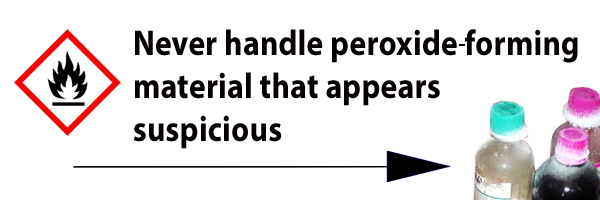

How to get help in an emergency

 |
Did you know...
- That containers of ethyl ether can become explosive over time?
- That ethyl ether is one of a group of chemicals that can form unstable peroxides?
- That peroxides can accumulate and possible detonate when you open the container?
A significant number of laboratory solvents can undergo autoxidation under normal storage conditions to form unstable and potentially dangerous peroxide by-products.
Potential peroxide-forming solvent categories:
1. Solvents that do not need to be pre-concentrated (see Group A)
2. Solvents that need pre-concentration in order to form peroxides (see Group B)
Group A: Chemicals that form explosive levels of peroxides without concentration Severe peroxide hazard after prolonged storage, especially after exposure to air. Test for peroxide formation before using or discard after 3 months.
Isopropyl ether
Group B: Peroxide hazards on concentration Test for peroxide formation before distillation or evaporation. Test for peroxide formation or discard after 1 year.
Acetal Ethylene glycol ether acetates
Acetaldehyde Furan
Benzyl Alcohol 4-Heptanol
2-Butanol 2-Hexanol
Dioxanes Methyl Acetylene
Chlorofluoroethylene 3-Methyl-1-butanol
Cumene(isopropylbenzene) Methyl-isobutyl ketone
Cyclohexene 4-Methyl-2-pentanol
2-Cyclohexen-1-ol 2-Pentanol
Cyclopentene 4-Penten-1-ol
Decahydronapthalene(decal in) 1-Phenylethanol
Diacetylene(butadiyne) Tetrahydrofuran
Dicyclopentadiene Tetrahydronapthalene
Diglyme Vinyl Ethers
Diethyl ether Sec. Alcohols
* Materials other than those listed may form peroxides. Applies only to pure materials.
The solvents most commonly used in the laboratory solvents, such as diethyl ether, tetrahydrofuran, cyclohexene, glycol ethers, decalin and 2-propanol are shown in Group B of the previous section. These compounds produce organic peroxides that are significantly less volatile than the solvent in which they are formed, as a result, evaporative concentration or distillation can produce dangerous levels of peroxides. In fact, most Group B solvents are sufficiently volatile that multiple openings of a single container can result in significant and dangerous peroxide concentration.
A variety of methods are available to test for the presence of peroxides in organic solvents with the two most common tests described below.
At present, 100 ppm is widely used as a general control point with respect to minimum hazardous peroxide concentration in a solvent, however, this value lacks scientific validation and is likely too liberal or conservative depending on the solvent in question and intended application.
If there are visible crystals, visible precipitate or an oily viscous layer present in the material, these are visual indicators of dangerous high peroxide levels, immediately contact your company's EH&S (Environmental, Health and Safety) department or its equivalent, to manage this hazardous situation and to dispose of this material.
In the presence of hydrogen peroxide the test paper turns blue. Quantofix® Peroxide test sticks can also be used for the determination of peracetic acid and other organic and inorganic hydroperoxides. To test for hydroperoxides in organic solvents, the test zone is wetted with one drop of water after evaporation of the solvent. Interferences: In the pH range of 2-9, the accuracy of the determination is independent of the pH of the test solution. Buffer strongly acidic solutions with sodium acetate and adjust alkaline solutions to about pH 5-7 with citric acid. Falsely positive results can only be caused by strong oxidizing agents. Storage: Avoid exposing the sticks to sunlight and moisture. Store unopened packs in refrigerator (+2 °C to +8 °C). Opened packs: store container in a cool and dry place.
Add 0.5-1.0 ml of the sample solvent to an equal volume of glacial acetic acid containing about 0.1 g of sodium iodide or potassium iodide crystals. A yellow color indicates iodine formation via iodide oxidation by sample peroxide; a brown color indicates high concentration. A blank determination should be made particularly when color development is faint since iodide/acetic acid mixtures will, over time, turn a yellow - brown color due to air oxidation.
A more sensitive variation of the above method adds one drop of a saturated, aqueous starch solution to the sample solution. Starch and iodine combine to form a bright blue complex that is more easily visualized than the yellow color generated by iodine alone. Dark blue solution color would be indicative of high peroxide concentrations.